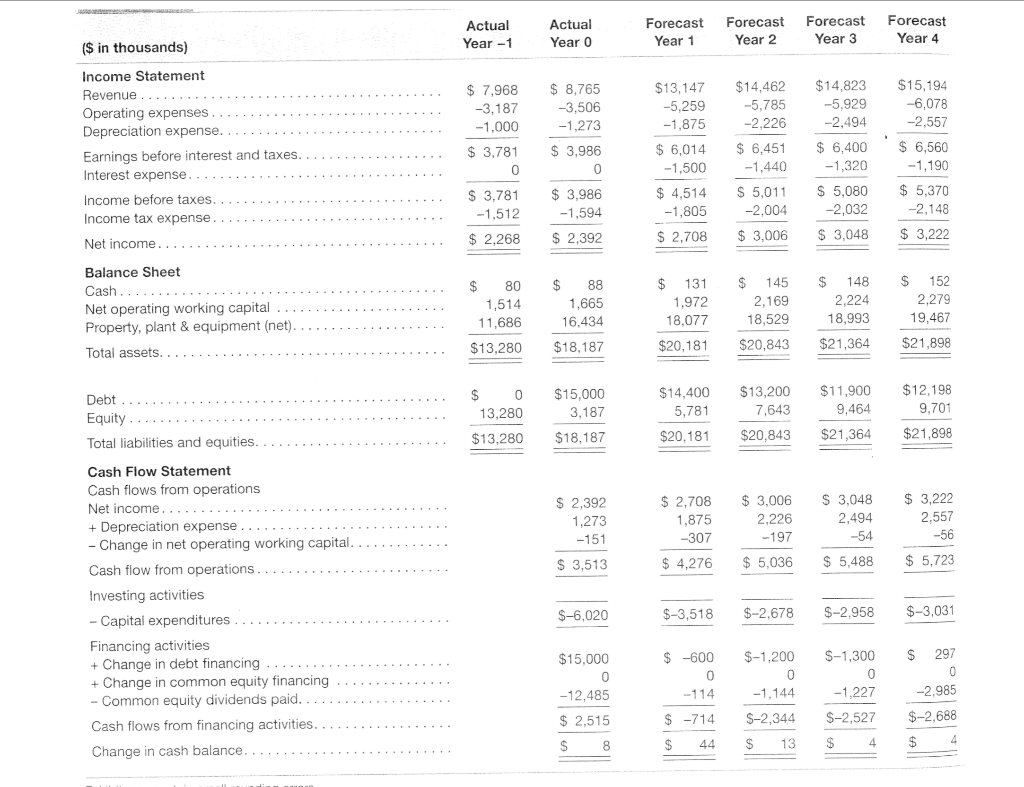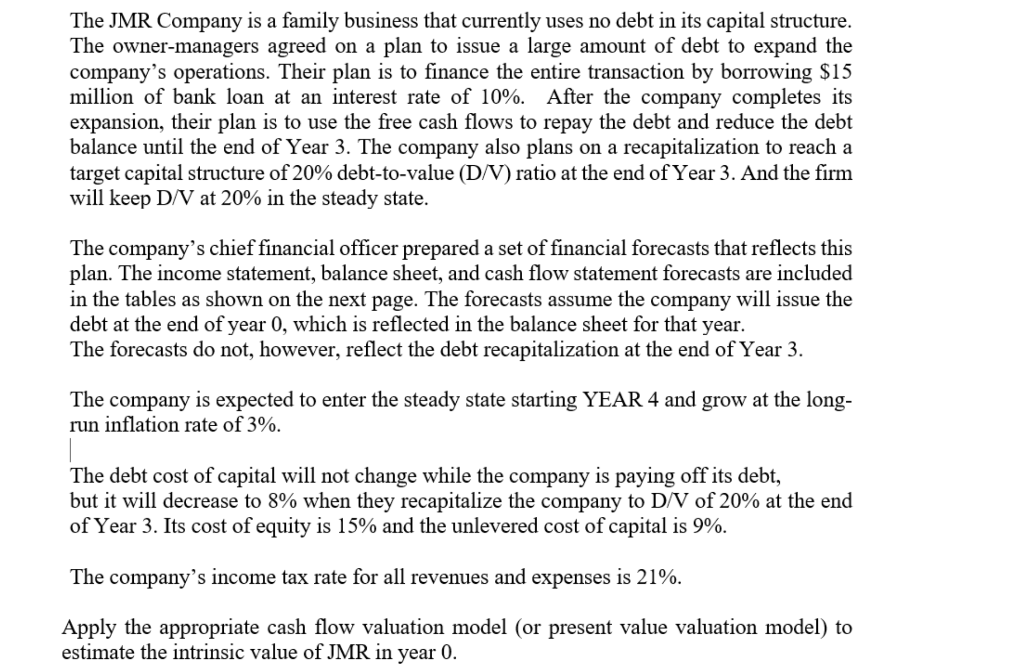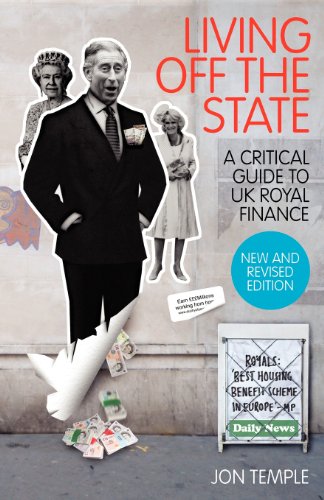

Actual Year -1 Actual Year o Forecast Year 1 Forecast Year 2 Forecast Year 3 Forecast Year 4 $ 8,765 -3,506 -1.273 $ 7,968 -3,187 -1.000 $ 3,781 0 $13,147 -5,259 -1,875 $14,462 -5.785 -2.226 $15,194 -6,078 -2,557 ($ in thousands) Income Statement Revenue Operating expenses Depreciation expense.. Earnings before interest and taxes. Interest expense Income before taxes. Income tax expense. Net income. $ 3,986 $ 6,014 -1,500 $ 4,514 -1,805 $14,823 -5,929 -2,494 $ 6,400 -1,320 $ 5.080 -2,032 $ 3,048 $ 3,781 -1,512 $ 2,268 $ 6,451 -1,440 $ 5,011 -2,004 $ 3,006 $ 3,986 -1,594 $ 6,560 -1,190 $ 5,370 -2,148 $ 3,222 $ 2,392 $ 2,708 Balance Sheet Cash... Net operating working capital Property, plant & equipment (net). Total assets. $ 80 1,514 11,686 $13,280 $ 88 1,665 16,434 $ 131 1,972 18,077 $20,181 $ 145 2,169 18,529 $20,843 $ 148 2,224 18,993 $21,364 $ 152 2,279 19.467 $18,187 $21,898 $ 0 13,280 $15,000 3,187 $14,400 5,781 $13,200 7,643 $11,900 9,464 $12.198 9,701 Debt Equity Total liabilities and equities. $13,280 $18,187 $20,181 $20,843 $21,364 $21,898 $ 2,392 1,273 -151 $ 2,708 1,875 -307 $ 3,006 2.226 -197 $ 3,048 2,494 -54 $ 3,222 2,557 -56 $ 5,723 $ 3,513 $ 4,276 $ 5,036 $ 5,488 Cash Flow Statement Cash flows from operations Net income.... + Depreciation expense. Change in net operating working capital. Cash flow from operations Investing activities - Capital expenditures Financing activities + Change in debt financing Change in common equity financing Common equity dividends paid. Cash flows from financing activities. Change in cash balance $-6,020 $-3,518 $-2,678 $-2,958 $-3,031 $15,000 $ -600 0 -114 $-1,200 0 -1,144 $-1,300 0 -1,227 $ 297 0 -2.985 $-2,688 -12,485 $ 2,515 $ -714 $-2,344 $-2,527 S 8 $ 44 $ 13 $ The JMR Company is a family business that currently uses no debt in its capital structure. The owner- managers agreed on a plan to issue a large amount of debt to expand the company's operations. Their plan is to finance the entire transaction by borrowing $15 million of bank loan at an interest rate of 10%. After the company completes its expansion, their plan is to use the free cash flows to repay the debt and reduce the debt balance until the end of Year 3. The company also plans on a recapitalization to reach a target capital structure of 20% debt-to-value (D/V) ratio at the end of Year 3. And the firm will keep D/V at 20% in the steady state. The company's chief financial officer prepared a set of financial forecasts that reflects this plan. The income statement, balance sheet, and cash flow statement forecasts are included in the tables as shown on the next page. The forecasts assume the company will issue the debt at the end of year 0, which is reflected in the balance sheet for that year. The forecasts do not, however, reflect the debt recapitalization at the end of Year 3. The company is expected to enter the steady state starting YEAR 4 and grow at the long- run inflation rate of 3%. The debt cost of capital will not change while the company is paying off its debt, but it will decrease to 8% when they recapitalize the company to D/V of 20% at the end of Year 3. Its cost of equity is 15% and the unlevered cost of capital is 9%. The company's income tax rate for all revenues and expenses is 21%. Apply the appropriate cash flow valuation model (or present value valuation model) to estimate the intrinsic value of JMR in year 0. Actual Year -1 Actual Year o Forecast Year 1 Forecast Year 2 Forecast Year 3 Forecast Year 4 $ 8,765 -3,506 -1.273 $ 7,968 -3,187 -1.000 $ 3,781 0 $13,147 -5,259 -1,875 $14,462 -5.785 -2.226 $15,194 -6,078 -2,557 ($ in thousands) Income Statement Revenue Operating expenses Depreciation expense.. Earnings before interest and taxes. Interest expense Income before taxes. Income tax expense. Net income. $ 3,986 $ 6,014 -1,500 $ 4,514 -1,805 $14,823 -5,929 -2,494 $ 6,400 -1,320 $ 5.080 -2,032 $ 3,048 $ 3,781 -1,512 $ 2,268 $ 6,451 -1,440 $ 5,011 -2,004 $ 3,006 $ 3,986 -1,594 $ 6,560 -1,190 $ 5,370 -2,148 $ 3,222 $ 2,392 $ 2,708 Balance Sheet Cash... Net operating working capital Property, plant & equipment (net). Total assets. $ 80 1,514 11,686 $13,280 $ 88 1,665 16,434 $ 131 1,972 18,077 $20,181 $ 145 2,169 18,529 $20,843 $ 148 2,224 18,993 $21,364 $ 152 2,279 19.467 $18,187 $21,898 $ 0 13,280 $15,000 3,187 $14,400 5,781 $13,200 7,643 $11,900 9,464 $12.198 9,701 Debt Equity Total liabilities and equities. $13,280 $18,187 $20,181 $20,843 $21,364 $21,898 $ 2,392 1,273 -151 $ 2,708 1,875 -307 $ 3,006 2.226 -197 $ 3,048 2,494 -54 $ 3,222 2,557 -56 $ 5,723 $ 3,513 $ 4,276 $ 5,036 $ 5,488 Cash Flow Statement Cash flows from operations Net income.... + Depreciation expense. Change in net operating working capital. Cash flow from operations Investing activities - Capital expenditures Financing activities + Change in debt financing Change in common equity financing Common equity dividends paid. Cash flows from financing activities. Change in cash balance $-6,020 $-3,518 $-2,678 $-2,958 $-3,031 $15,000 $ -600 0 -114 $-1,200 0 -1,144 $-1,300 0 -1,227 $ 297 0 -2.985 $-2,688 -12,485 $ 2,515 $ -714 $-2,344 $-2,527 S 8 $ 44 $ 13 $ The JMR Company is a family business that currently uses no debt in its capital structure. The owner- managers agreed on a plan to issue a large amount of debt to expand the company's operations. Their plan is to finance the entire transaction by borrowing $15 million of bank loan at an interest rate of 10%. After the company completes its expansion, their plan is to use the free cash flows to repay the debt and reduce the debt balance until the end of Year 3. The company also plans on a recapitalization to reach a target capital structure of 20% debt-to-value (D/V) ratio at the end of Year 3. And the firm will keep D/V at 20% in the steady state. The company's chief financial officer prepared a set of financial forecasts that reflects this plan. The income statement, balance sheet, and cash flow statement forecasts are included in the tables as shown on the next page. The forecasts assume the company will issue the debt at the end of year 0, which is reflected in the balance sheet for that year. The forecasts do not, however, reflect the debt recapitalization at the end of Year 3. The company is expected to enter the steady state starting YEAR 4 and grow at the long- run inflation rate of 3%. The debt cost of capital will not change while the company is paying off its debt, but it will decrease to 8% when they recapitalize the company to D/V of 20% at the end of Year 3. Its cost of equity is 15% and the unlevered cost of capital is 9%. The company's income tax rate for all revenues and expenses is 21%. Apply the appropriate cash flow valuation model (or present value valuation model) to estimate the intrinsic value of JMR in year 0








